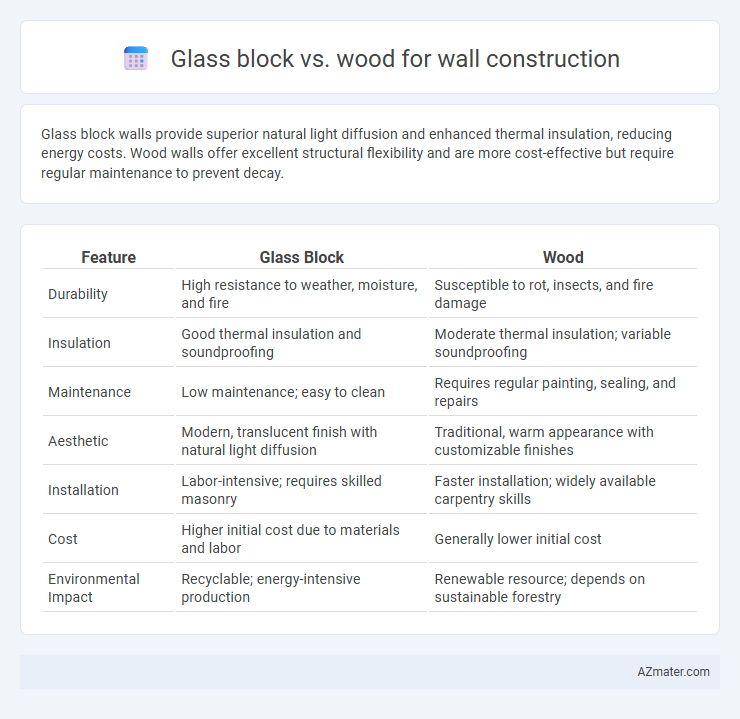Glass block walls provide superior natural light diffusion and enhanced thermal insulation, reducing energy costs. Wood walls offer excellent structural flexibility and are more cost-effective but require regular maintenance to prevent decay.
Table of Comparison
| Feature | Glass Block | Wood |
|---|---|---|
| Durability | High resistance to weather, moisture, and fire | Susceptible to rot, insects, and fire damage |
| Insulation | Good thermal insulation and soundproofing | Moderate thermal insulation; variable soundproofing |
| Maintenance | Low maintenance; easy to clean | Requires regular painting, sealing, and repairs |
| Aesthetic | Modern, translucent finish with natural light diffusion | Traditional, warm appearance with customizable finishes |
| Installation | Labor-intensive; requires skilled masonry | Faster installation; widely available carpentry skills |
| Cost | Higher initial cost due to materials and labor | Generally lower initial cost |
| Environmental Impact | Recyclable; energy-intensive production | Renewable resource; depends on sustainable forestry |
Introduction to Wall Construction Materials
Glass blocks offer durability, natural light diffusion, and moisture resistance, making them ideal for modern wall construction that emphasizes aesthetics and energy efficiency. Wood provides versatility, ease of installation, and excellent thermal insulation but requires maintenance to prevent decay and insect damage. Selecting between glass blocks and wood depends on factors such as climate, design preferences, budget, and structural requirements.
Overview of Glass Block Walls
Glass block walls provide a unique combination of natural light diffusion and privacy, making them an ideal choice for both interior and exterior applications. These walls offer high durability, excellent thermal insulation, and resistance to moisture and fire, surpassing many traditional materials like wood in long-term maintenance and energy efficiency. Their modular design allows for creative architectural patterns, enhancing both aesthetic appeal and functional lighting in modern construction projects.
Understanding Wood Walls
Wood walls offer excellent natural insulation, enhancing energy efficiency in residential construction while providing structural flexibility and ease of installation. Unlike glass blocks, wood walls allow for better sound absorption and moisture regulation, contributing to a healthier indoor environment. Wood's renewable nature and capacity for customization make it a sustainable choice for both exterior and interior wall applications.
Aesthetic Differences: Glass Block vs Wood
Glass block walls offer a modern, sleek aesthetic with translucent qualities that allow natural light to diffuse through, creating a bright and open atmosphere. Wood walls provide a warm, natural, and textured appearance, adding rustic charm and a sense of coziness to interior and exterior spaces. The choice between glass block and wood significantly impacts the visual style, with glass emphasizing light and transparency, while wood emphasizes organic warmth and tactile richness.
Insulation and Energy Efficiency Comparison
Glass blocks provide superior natural light transmission but generally have lower thermal insulation compared to wood, leading to higher heat transfer rates. Wood offers excellent insulation properties due to its low thermal conductivity, enhancing energy efficiency by reducing heating and cooling demands. For wall construction, wood typically ensures better energy conservation, while glass blocks may require additional insulating measures to achieve comparable performance.
Structural Strength and Durability
Glass blocks offer high compressive strength and excellent durability against weather and moisture, making them resistant to wear and corrosion in wall construction. Wood provides good tensile strength and flexibility but is susceptible to rot, insect damage, and warping over time without proper treatment. In terms of long-term structural integrity, glass blocks outperform wood in resistance to environmental degradation while wood remains favored for ease of modification and thermal insulation properties.
Acoustic Performance: Sound Insulation
Glass blocks offer moderate sound insulation due to their density and airtight installation, effectively reducing airborne noise but less effective against low-frequency sounds. Wood walls, especially those with added insulation and air gaps, provide superior acoustic performance by absorbing and dampening a broader range of sound frequencies. For optimal soundproofing in wall construction, combining wood framing with specialized acoustic insulation materials outperforms the inherent properties of glass blocks.
Cost Analysis: Installation and Maintenance
Glass block walls typically incur higher installation costs due to specialized labor and materials required for precise fitting and sealing, while wood walls generally offer lower upfront expenses with more straightforward construction processes. Maintenance costs for glass blocks are minimal, primarily involving occasional cleaning and sealant inspections to prevent moisture infiltration. In contrast, wood walls demand regular upkeep such as painting, sealing, and potential repairs to address rot, insect damage, and weathering, leading to higher long-term maintenance expenses.
Sustainability and Environmental Impact
Glass blocks offer superior sustainability due to their recyclability and ability to maximize natural daylight, reducing energy consumption for lighting and heating in wall construction. Wood, while renewable and carbon-sequestering, requires responsible sourcing and treatment to prevent environmental degradation and promote long-term durability. Choosing between glass block and wood depends on evaluating embodied energy, durability, and lifecycle emissions to minimize environmental impact effectively.
Choosing the Right Material for Your Project
Glass blocks offer excellent natural light transmission and moisture resistance, making them ideal for bathrooms, kitchens, and exterior walls requiring durability and aesthetic appeal. Wood provides superior thermal insulation, versatility, and ease of customization, suitable for interior walls, framing, and traditional construction projects. Assess factors like climate, insulation needs, design preferences, and maintenance requirements to determine whether glass block or wood aligns best with your project's functional and aesthetic goals.

Infographic: Glass block vs Wood for Wall construction
 azmater.com
azmater.com